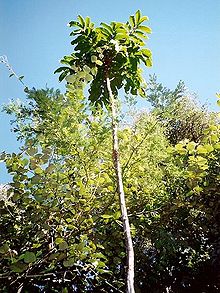- Diploglottis cunninghamii
-
Native Tamarind 
Native Tamarind growing at Barrington Tops, Australia Scientific classification Kingdom: Plantae (unranked): Angiosperms (unranked): Eudicots (unranked): Rosids Order: Sapindales Family: Sapindaceae Genus: Diploglottis
F. MuellSpecies: D. cunninghamii Binomial name Diploglottis cunninghamii
Hook. ex Benth.Synonyms - Diploglottis australis G. Don, Radlk.
- Stadmannia australis G.Don
Diploglottis cunninghamii, known as the Native Tamarind is a common rainforest tree of eastern Australia. It is easily identified by the large sausage shaped leaves.
The Native Tamarind grows in a variety of different rainforests, on basaltic and rich alluvial soils. The southern most limit of natural distribution is Brogo[citation required] near Bega (36° S) in New South Wales. It appears along the east coast to near Proserpine (20° S) in tropical Queensland[1].
Description
A medium to large tree with long and broad leaves. Achieving a height of over 35 metres tall and 75 cm in diameter. The trunk is cylindrical and flanged at the base, somewhat resembling the trunk of the Coachwood.
The leaves are pinnate and alternate, some over 30 cm long. Broad elliptic, bluntly pointed at the tip, not equal at the base, often covered with velvety golden brown hairs. The leaf veins are easy to see on both sides, more so on the underneath. The midrib is slightly raised on the top surface.
Flowers form in spring, being creamy brown in large and hairy panicles. The brown and hairy capsule matures form October to January. Containing a yellow/orange aril, which is pleasant to taste. Within the aril is a triangular and pale brown seed.
Seed germination is reliable, and fast, although if collected from damp ground where it falls in large quantity, the seed may be heavily infested with insect grubs. Fruit eaten by a large variety of rainforest birds, including the Brown Cuckoo Dove, Crimson rosella, Australasian Figbird, Green Catbird, Regent bowerbird, Rose-crowned Fruit-dove, Topknot Pigeon and Wompoo Fruit-Dove.
Uses
A decorative and ornamental tree, seen growing in various parts of urban Australia. Including the city of Sydney, (behind the Mitchell Library). Native Tamarind should be kept away from windy situations because of the large leaves. The aril may be eaten raw, added to jams and chutneys and makes a tangy cool drink. .
-
large Diploglottis cunninghamii in private property near the Watagans National Park
References
- ^ Floyd, A.G., Rainforest Trees of Mainland South-eastern Australia, Inkata Press 1989, ISBN 0-909605-57-2
- Floyd, A.G., Rainforest Trees of Mainland South-eastern Australia, Inkata Press 1989, ISBN 0-909605-57-2
- "Diploglottis cunninghamii". PlantNET - NSW Flora Online. http://pngplants.org/cgi-bin/NSWfl.pl?page=nswfl&lvl=sp&name=Diploglottis~cunninghamii. Retrieved 2009-05-26.
Categories:- Sapindaceae
- Sapindales of Australia
- Trees of Australia
- Ornamental trees
- Flora of Queensland
- Flora of New South Wales
Wikimedia Foundation. 2010.




